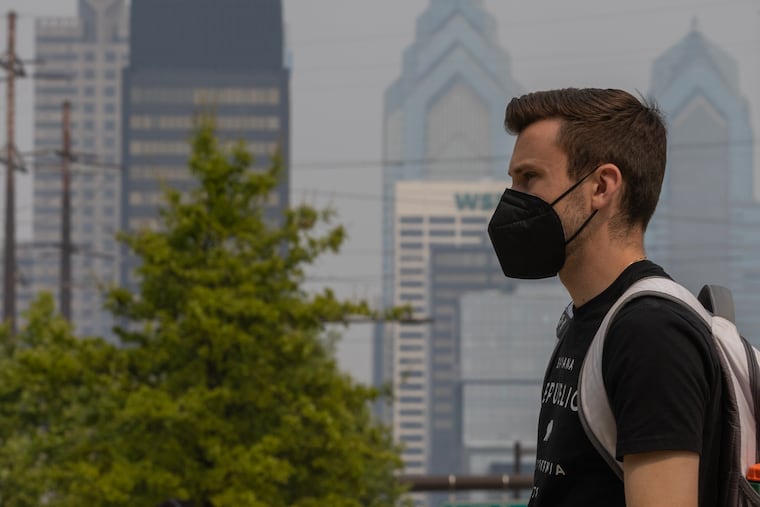Air quality in Philadelphia reaches ‘unhealthy’ levels for some as fires in Canada burn
Forecasts show a westerly flow of air that will continue to bring some wildfire smoke into the Philadelphia region, which could linger through Saturday.

After blanketing Chicago and parts of the Midwest, smoke from wildfires in Canada has blown into Philadelphia.
Both the Pennsylvania Department of Environmental Protection and Philadelphia’s Department of Public Health declared a “code red” air quality warning Wednesday, which the city health department later extended through Thursday, as fine particulate matter from smoke stemming from Canadian wildfires has once again made its way south.
Young children, the elderly, and those with respiratory problems, such as asthma, emphysema, and bronchitis, are especially vulnerable to the effects of air pollution, and officials suggest members of those groups avoid outdoor activities.
The air quality index in Philadelphia as of 2 p.m. was 145, according to government data. That’s enough to place the city in the orange “unhealthy for sensitive groups” category.
Newark, Del., had the worst air quality in the region Wednesday afternoon with a 152 air quality index, rated as “unhealthy” for all residents.
Officials said they were working with recreation centers across the city to ensure youth programming could be moved indoors if the air quality continued to worsen. Pools were to remain open in Philadelphia unless the air quality reaches levels where it could be dangerous for all people, the city said.
The health department recommended residents consider canceling outdoor events and gatherings and closing all windows and doors to minimize air pollution in the home. If you must go outdoors, the city suggested wearing a high-quality mask and avoiding areas of high congestion, such as main streets or highways.
Stronger concentrations of smoke from the west were expected to drift into eastern Pennsylvania throughout the afternoon and evening Wednesday, but were not expected to approach the dangerous levels reached earlier this month, according to National Weather Service meteorologist Alex Dodd.
“We aren’t expecting the values they’re experiencing across the Midwest and to the west of the Appalachians to get this far east,” Dodd said. “By the time the air gets all the way across the Appalachians, the particulate matter numbers aren’t as high.”
Forecasts for Thursday show a westerly flow of air across the Appalachians from the Midwest that will continue to bring some wildfire smoke into the Philadelphia region, Dodd said. That could linger through Saturday, when showers and thunderstorms are expected in and around Philadelphia.
“The rain helps draw the particulate matter out of the air,” Dodd said.
What is the air quality index?
The U.S. Environmental Protection Agency pulls data from gauges that measure various pollutants in real time. In this case, the EPA uses data collected by Philadelphia’s Air Quality Management Services.
The EPA sets limits for each pollutant for its air quality index (AQI). The level of each pollutant is color-coded based on the highest daily AQI value at selected monitors. The Philadelphia Health Department lists six levels, from lowest to highest: green, yellow, orange, red, purple, and maroon — a level considered “hazardous.”
Earlier this month, Philadelphia reached the maroon “hazardous” level, the worst air quality since at least 2008 if not before, according to historical EPA data. The poor air quality forced people across the city indoors and led to several events, including a Phillies game, to be canceled or postponed.
What is PM2.5?
PM2.5 is fine particulate matter defined as concentrations of 2.5 microns or smaller. It’s of special concern because the particles are so small — far smaller than the width of a human hair — and are easily inhaled. The World Health Organization says PM2.5 is responsible for the biggest proportion of health effects from air pollution.
Locally, the biggest typical sources of PM2.5 are emissions from gas and diesel-powered vehicles. Power plants are also a source. The particles form when emissions react in the air.
But wildfires burning in multiple Canadian provinces and territories contain a mixture of gaseous pollutants and PM2.5 is a chief component.
Particle pollution refers to a mix of solid and liquid droplets in the air. Some particles are so small that they are visible using only an electron microscope. Those particles can penetrate both indoors and outdoors because of their small size. During wildfires, concentrations can rise so high that particles are visible to the naked eye as part of the mix of gases in a haze.
Staff writer Frank Kummer contributed to this article.